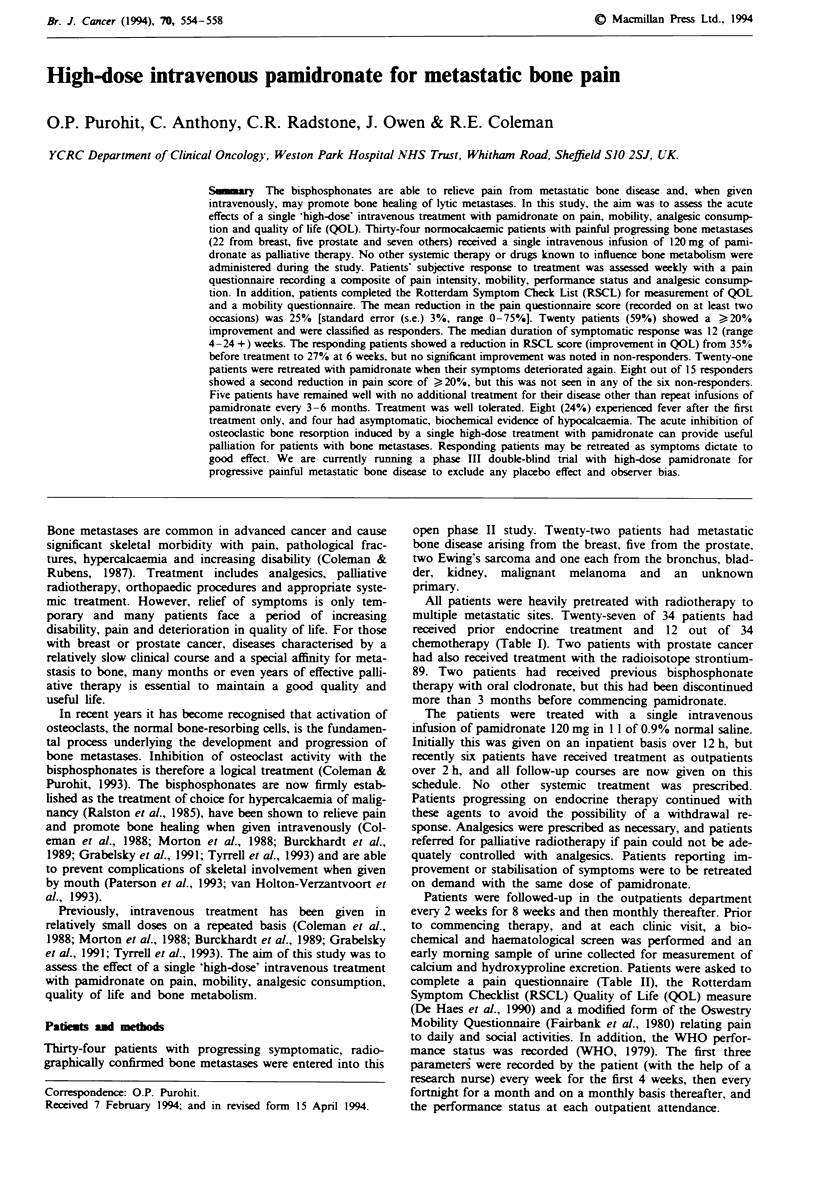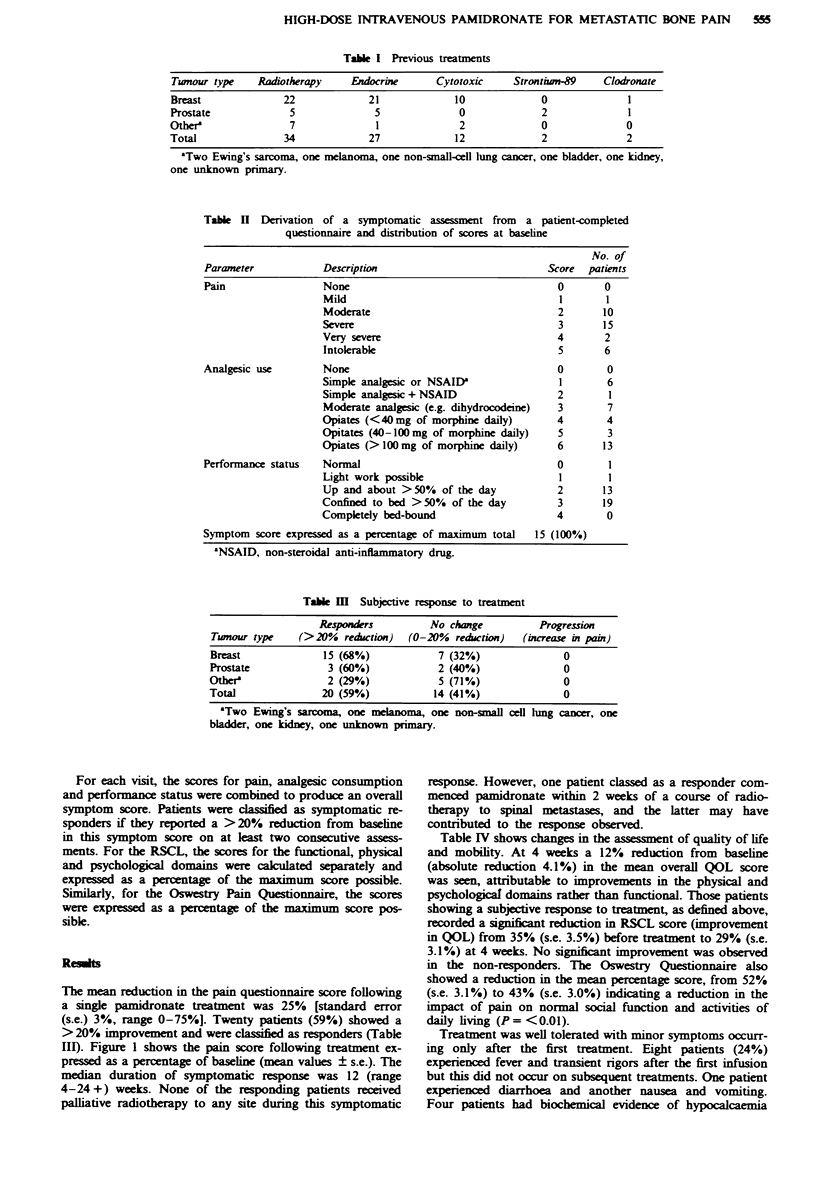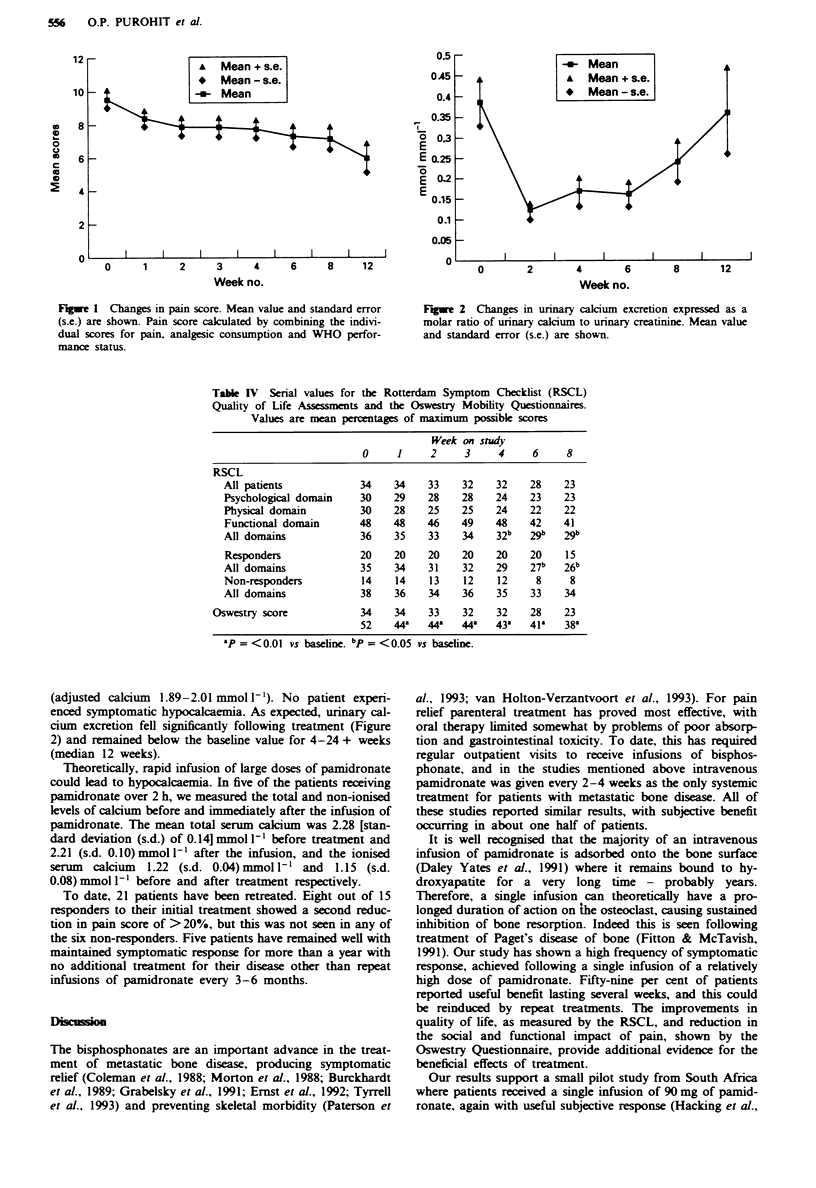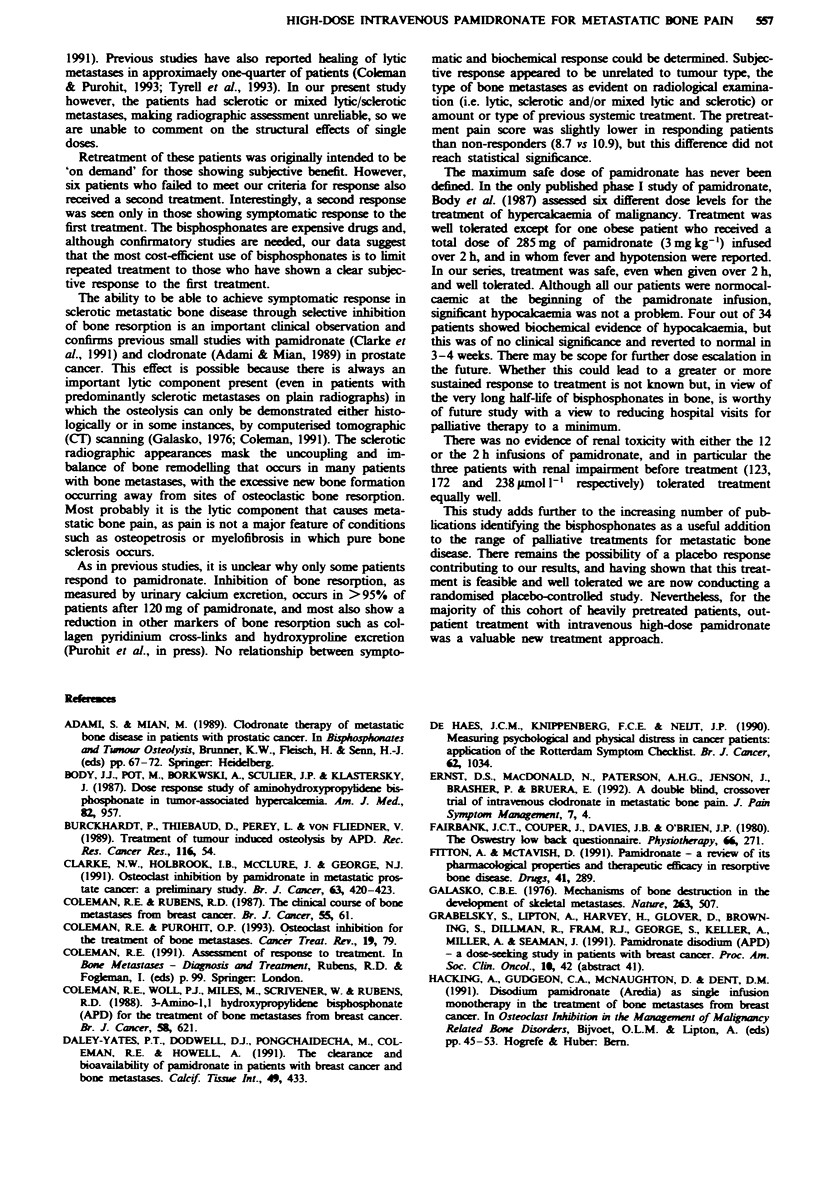Abstract
The bisphosphonates are able to relieve pain from metastatic bone disease and, when given intravenously, may promote bone healing of lytic metastases. In this study, the aim was to assess the acute effects of a single 'high-dose' intravenous treatment with pamidronate on pain, mobility, analgesic consumption and quality of life (QOL). Thirty-four normocalcaemic patients with painful progressing bone metastases (22 from breast, five prostate and seven others) received a single intravenous infusion of 120 mg of pamidronate as palliative therapy. No other systemic therapy or drugs known to influence bone metabolism were administered during the study. Patients' subjective response to treatment was assessed weekly with a pain questionnaire recording a composite of pain intensity, mobility, performance status and analgesic consumption. In addition, patients completed the Rotterdam Symptom Check List (RSCL) for measurement of QOL and a mobility questionnaire. The mean reduction in the pain questionnaire score (recorded on at least two occasions) was 25% [standard error (s.e.) 3%, range 0-75%]. Twenty patients (59%) showed a > or = 20% improvement and were classified as responders. The median duration of symptomatic response was 12 (range 4-24 +) weeks. The responding patients showed a reduction in RSCL score (improvement in QOL) from 35% before treatment to 27% at 6 weeks, but no significant improvement was noted in non-responders. Twenty-one patients were retreated with pamidronate when their symptoms deteriorated again. Eight out of 15 responders showed a second reduction in pain score of > or = 20%, but this was not seen in any of the six non-responders. Five patients have remained well with no additional treatment for their disease other than repeat infusions of pamidronate every 3-6 months. Treatment was well tolerated. Eight (24%) experienced fever after the first treatment only, and four had asymptomatic, biochemical evidence of hypocalcaemia. The acute inhibition of osteoclastic bone resorption induced by a single high-dose treatment with pamidronate can provide useful palliation for patients with bone metastases. Responding patients may be retreated as symptoms dictate to good effect. We are currently running a phase III double-blind trial with high-dose pamidronate for progressive painful metastatic bone disease to exclude any placebo effect and observer bias.
Full text
PDF




Selected References
These references are in PubMed. This may not be the complete list of references from this article.
- Adami S., Mian M. Clodronate therapy of metastatic bone disease in patients with prostatic carcinoma. Recent Results Cancer Res. 1989;116:67–72. doi: 10.1007/978-3-642-83668-8_6. [DOI] [PubMed] [Google Scholar]
- Body J. J., Pot M., Borkowski A., Sculier J. P., Klastersky J. Dose/response study of aminohydroxypropylidene bisphosphonate in tumor-associated hypercalcemia. Am J Med. 1987 May;82(5):957–963. doi: 10.1016/0002-9343(87)90158-6. [DOI] [PubMed] [Google Scholar]
- Clarke N. W., Holbrook I. B., McClure J., George N. J. Osteoclast inhibition by pamidronate in metastatic prostate cancer: a preliminary study. Br J Cancer. 1991 Mar;63(3):420–423. doi: 10.1038/bjc.1991.97. [DOI] [PMC free article] [PubMed] [Google Scholar]
- Coleman R. E., Purohit O. P. Osteoclast inhibition for the treatment of bone metastases. Cancer Treat Rev. 1993 Jan;19(1):79–103. doi: 10.1016/0305-7372(93)90028-p. [DOI] [PubMed] [Google Scholar]
- Coleman R. E., Woll P. J., Miles M., Scrivener W., Rubens R. D. Treatment of bone metastases from breast cancer with (3-amino-1-hydroxypropylidene)-1,1-bisphosphonate (APD). Br J Cancer. 1988 Nov;58(5):621–625. doi: 10.1038/bjc.1988.272. [DOI] [PMC free article] [PubMed] [Google Scholar]
- Daley-Yates P. T., Dodwell D. J., Pongchaidecha M., Coleman R. E., Howell A. The clearance and bioavailability of pamidronate in patients with breast cancer and bone metastases. Calcif Tissue Int. 1991 Dec;49(6):433–435. doi: 10.1007/BF02555856. [DOI] [PubMed] [Google Scholar]
- Fairbank J. C., Couper J., Davies J. B., O'Brien J. P. The Oswestry low back pain disability questionnaire. Physiotherapy. 1980 Aug;66(8):271–273. [PubMed] [Google Scholar]
- Fitton A., McTavish D. Pamidronate. A review of its pharmacological properties and therapeutic efficacy in resorptive bone disease. Drugs. 1991 Feb;41(2):289–318. doi: 10.2165/00003495-199141020-00009. [DOI] [PubMed] [Google Scholar]
- Morton A. R., Cantrill J. A., Pillai G. V., McMahon A., Anderson D. C., Howell A. Sclerosis of lytic bone metastases after disodium aminohydroxypropylidene bisphosphonate (APD) in patients with breast carcinoma. BMJ. 1988 Sep 24;297(6651):772–773. doi: 10.1136/bmj.297.6651.772. [DOI] [PMC free article] [PubMed] [Google Scholar]
- Paterson A. H., Powles T. J., Kanis J. A., McCloskey E., Hanson J., Ashley S. Double-blind controlled trial of oral clodronate in patients with bone metastases from breast cancer. J Clin Oncol. 1993 Jan;11(1):59–65. doi: 10.1200/JCO.1993.11.1.59. [DOI] [PubMed] [Google Scholar]
- Ralston S. H., Gardner M. D., Dryburgh F. J., Jenkins A. S., Cowan R. A., Boyle I. T. Comparison of aminohydroxypropylidene diphosphonate, mithramycin, and corticosteroids/calcitonin in treatment of cancer-associated hypercalcaemia. Lancet. 1985 Oct 26;2(8461):907–910. doi: 10.1016/s0140-6736(85)90848-7. [DOI] [PubMed] [Google Scholar]
- de Haes J. C., van Knippenberg F. C., Neijt J. P. Measuring psychological and physical distress in cancer patients: structure and application of the Rotterdam Symptom Checklist. Br J Cancer. 1990 Dec;62(6):1034–1038. doi: 10.1038/bjc.1990.434. [DOI] [PMC free article] [PubMed] [Google Scholar]
- van Holten-Verzantvoort A. T., Kroon H. M., Bijvoet O. L., Cleton F. J., Beex L. V., Blijham G., Hermans J., Neijt J. P., Papapoulos S. E., Sleeboom H. P. Palliative pamidronate treatment in patients with bone metastases from breast cancer. J Clin Oncol. 1993 Mar;11(3):491–498. doi: 10.1200/JCO.1993.11.3.491. [DOI] [PubMed] [Google Scholar]


